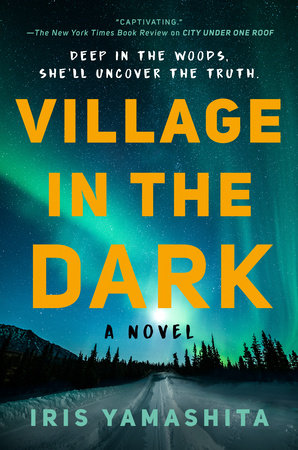Village in the Dark: A Novel
- By Iris Yamashita
- Berkley
- 288 pp.
- Reviewed by Nick Havey
- March 19, 2024
Detective Cara Kennedy returns to Point Mettier, AK, in her smart sophomore whodunit.

When I was a child, Angela Lansbury’s “Murder, She Wrote” was my comfort program. I’d watch hours of it on sick days, wondering why people kept inviting this lovely old woman places if she was just going to solve whatever crime they’d committed, bringing doom upon them like an adorably dressed Angel of Death. While she traveled far and wide, investigating the killings of nieces’ and nephews’ acquaintances, Lansbury’s Jessica Fletcher was at her best at home in Cabot Cove. And even when she wasn’t there, she was in specific locations (e.g., Palm Springs, the Hamptons, Broadway). A strong sense of place was an indelible part of what made the show — outside of its talent — work.
Iris Yamashita, a celebrated screenwriter whose debut novel, City Under One Roof, took the small, tight-knit community of Point Mettier, Alaska, and introduced into it a closed-room murder, knows something about the power of place herself. So it’s no surprise that her heroine, Detective Cara Kennedy, returns to Point Mettier, the Davidson Condos (aka the Dave-Co, the town’s only residential building), and the charming locals she offended and later befriended in Village in the Dark, a whodunit that picks up right where City Under One Roof left off.
The conclusion of her last case brought Cara one step closer to unraveling the mystery surrounding the disappearance and death a year earlier of her husband, Aaron, and their young son, Dylan. After having their bodies exhumed to determine if they were murdered, Cara must piece together the connection between them and the other people — some missing — whose photos appear on a now-dead killer’s phone. Figuring out what they all have in common might be key to stopping the carnage.
Cara’s first clue is a shot of Timmy MacCullum, whose body is found shortly after she begins her investigation. His mother, Ellie, is Point Mettier’s innkeeper and gunslinging skeptic-turned-ally to Cara who just wants to know why her estranged son was killed. As the pair investigates the murders, Yamashita introduces us to a new POV character named Mia, who is pretending to be Carol and used to be Jennifer. Her picture is on the phone, too.
Yamashita deftly drops breadcrumbs for the reader, all of which lead back to Almagor, where Aaron worked in medical testing. The pharmaceutical company is a huge player in the Anchorage economy and has enough power over local law enforcement to falsify medical records and intervene in murder investigations. As we learn more about the grift the company is running, Cara falls further into many suspects’ crosshairs.
Luckily, this time around, she has friends, and her colorful Point Mettier squad is more than capable of piecing together the puzzle and ensuring that Aaron, Dylan, Timmy, and the other victims of Almagor’s scheming find justice. In the end, all roads lead to the titular “village in the dark,” a male-free place called Unity, where Mia/Carol/Jennifer hails from and where women running from something (almost unilaterally the violence of men) can live in peace.
Village in the Dark, like City Under One Roof before it, is a successful thriller that offers welcome social commentary and a fully realized setting. The beautiful Alaskan wilderness makes the novel’s third act significantly more interesting than its police-procedural second, and Unity provides a vibrant, easy-to-visualize locale for the story’s memorable climax. Cara Kennedy may not have the star power of Jessica Fletcher — and is, honestly, carried by the more-interesting side characters — but there’s no doubt in my mind Iris Yamashita will continue to craft compelling mysteries with or without her.
Nick Havey is director of Institutional Research at the American Association of Colleges of Nursing, a thriller and mystery writer, and a lover of all fiction. His work has appeared in the Compulsive Reader, Lambda Literary, and a number of peer-reviewed journals.

